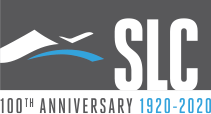Airport History
The Salt Lake City Airport’s 100-Year Evolution
From air mail outpost to world-class hub, Salt Lake City International Airport has historically been a crossroads connecting the community to the world. On December 21st, 2020, the Salt Lake City Department of Airports commemorated its 100-year anniversary out of a brand new airport. In honor of this achievement, a 100-year history book and video documentary have been created, and we invite you to join in the celebration by viewing them below. |  |
Airport Memories
Celebrity sightings. Love stories. Doppelgängers. Heart-wrenching goodbyes. They all happen at the Salt Lake City International Airport, along with lots of other experiences that are touching, memorable, hilarious, or just downright weird. Ready to share yours? To share a story, memory or photo, please go to SLC Stories.
Salt Lake City International Airport Timeline
2023
Completed Phase 2 of The New SLC with the addition of 22 gates and 19 concessions in Concourse A-east. Continued construction of Phase 3 and began infrastructure work for Phase 4.
2021
Began construction of a permanent tunnel to connect the Terminal to Concourse B. Demolished original airport facilities that were built in 1960 and beyond, including Terminals 1 and 2, the International Terminal, Concourses C, D, F and G, and the Parking Garage.
2020
Completed Phase 1 of The New SLC, which includes the Rental Car Service and Quick Turn Around facilities, a Parking Garage, Central Terminal, Concourse A-west and Concourse B. Demolition of former airport facilities is underway in preparation for Phase 2 to be completed in late 2024/early 2025. Phase 2 includes the build out of Concourse A to the east and creation of the shell for a Central Tunnel.
2014
Salt Lake City's Terminal Redevelopment Program breaks ground.
2009
Runway deicing project begins.
2005
Bag claim carousel modifications, Explosive Detection System (EDS) upgrades in Terminal 2, sterile corridor extension (two gates added), and reconfiguration of the east landside area.
2004
Reconfiguration of the west landside area.
2002
The city and airport hosted the Olympic Winter Games.
1999
The Federal Aviation Administration opened a new air traffic control tower and terminal radar approach control facility. Fire Station #11 was relocated to the east side of the airfield and the airport interior received major renovation.
1998
United Parcel Service became the first tenant in the north cargo complex with a new processing facility.
1997
A regional Aircraft Rescue Fire Fighter Training Center was built. (The training center closed July 2018)
1996
Southwest Airlines opened a reservations center.
1995
A third air carrier runway, Concourse E and the International Terminal were completed.
1994
A building to house the National Weather Service on the airport's east side was opened.
1992
A hangar and training facility for SkyWest Airlines opened.
1991
A four-level, short-term parking terrace and an 18-hole golf course, Wingpointe, were built.
1987
Western Airlines merged with Delta Air Lines. The hub operation was expanded and additional facilities were required.
1985
Ground access improvements were completed, runways were rehabilitated and support facilities were built.
1984
Terminal 2 was expanded to accommodate an additional concourse.
1982
Western Airlines made Salt Lake City an operational hub, requiring additional facility upgrades.
1981
Terminal 1 was expanded and remodeled.
1978
Terminal 2 was completed to house Western Airlines. A new Executive Terminal was also completed that year on the east side of the airport to serve general aviation needs and house various agencies. The west runway and taxiway systems were extended.
1975
From 1975 to 1980 the airport grew to 7,500 acres.
1968
The airport was renamed the "Salt Lake City International Airport."
1960
A new terminal building (currently Terminal 1) was dedicated. It was a seven-year $8,000,000 improvement project.
1950
The jet age ushered in major improvements including upgrading of the three runways to support the largest commercial jet aircraft, and equipping the primary runway with a Category II Instrument Landing System (ILS).
1943
The airport became a training base and replacement depot for the U.S. Air Force. Salt Lake City Municipal Airport II was built at the southwest end of the Salt Lake Valley to accommodate the number of trainees. It is now South Valley Regional Airport.
1933
At a cost of $52,000, Salt Lake City built an airport administration building that housed a passenger waiting room, mail room, airport manager's office, lunch room, weather observatory, radio control room and leased office space to airlines. A third runway was also added.
1930
Woodward Field was renamed "Salt Lake City Municipal Airport." It consisted of 400 acres, 11 hangars and two gravel runways.
1927
Charles "Lucky Lindy" Lindbergh made a stopover at Woodward Field. Salt Lake City residents had an opportunity to see his "Spirit of St. Louis," the first monoplane to cross the Atlantic Ocean.
1926
The first commercial passenger flight took place at Woodward Field. Ben F. Redman and J. A. Tomlinson perched atop U.S. mail sacks and flew with pilot C. N. "Jimmy" James on his regular eight-hour mail delivery flight to Los Angeles. This Western Air Express operation was the beginning of Western Airlines, which later merged with Delta Air Lines.
1925
A. R. "Tailspin Tommy" Thompson purchased the business and sponsored aerobatic shows at the fledgling airport.
1922
Ken Unger opened Unger Aviation at Woodward Field.
1920
Salt Lake City purchased 100 acres surrounding the landing strip for $40.00 per acre. The resulting airfield was named "Woodward Field," after local pilot John P. Woodward. World heavyweight boxing champion Jack Dempsey was on hand to help christen the airfield, which was a mail service facility only.
1911
A cinder-covered landing strip in a marshy pasture called Basque Flats (after the Spanish- French sheepherders in the area) was the rudimentary beginning of the airport. It was originally used for aerobatic flights and was the site of the "Great International Aviation Carnival."


